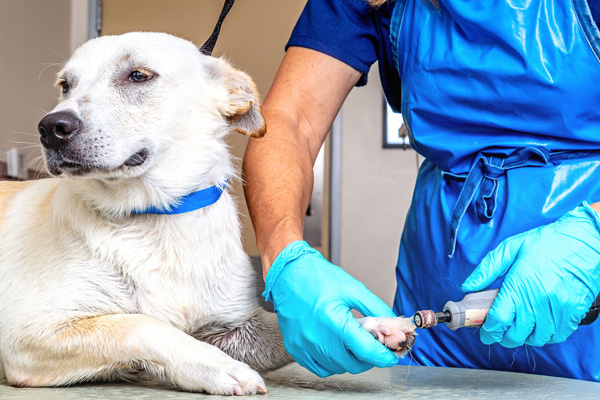Few things will send a dog skittering in terror like the nail clippers. Even the most easy going dogs don’t love it, and trimming can be stressful for dogs and owners alike. Those nails are technically claws. They’re sharp.
The best way to get a dog comfortable with a pawdicure is to start when they are a puppy and condition them to associate treats and affection with getting their nails cut. If you’ve adopted or rescued a dog, you have no control over how they feel about having their nails trimmed.
Maybe you get lucky and they suffer through it stoically and without much wriggling. But maybe not.
Keeping a dog’s claws at a healthy length, which is just above the ground when your dog is standing, is important! If the nails are too long, they can push back into the nail bed, which is painful for your dog and might cause long term damage to their feet.
While walking on cement and other hard surfaces does naturally wear down nail growth, some urban and suburban dogs don’t get enough friction to keep their claws at an ideal length. A dog who spends most of its time on carpet and lawn may need its nails cut more often than one who runs on hard packed dirt, gravel or cement.
Taking your dog to a professional dog groomer is a viable option. If you want trim nails at home because you have an anxious dog, or one who doesn’t like strangers, or to save some money, you need to make sure you have the right tools.
What can you use to trim your dog’s nails?
There are several types of nail trimmers:
The guillotine type — these are considered the easiest type to use even for beginners, and are readily available online and at pet stores. Look for one with a safety stop and one that is reasonably sharp.
The scissors type — if your dog’s nails are overgrown into a circle, you may need this type. It’s also a good option for overgrown dew claws. It’s also easy to find at stores.
A grinder — this is becoming a popular option and is especially useful when dealing with small, squirmy dogs, or if it’s difficult to see your dog’s quick. (More on that below). Dog friendly grinders look like a small, handheld sander designed for nail trimming. They can be noisy and might not be the best option for a dog afraid of loud noises.

Before you trim, understand your dog’s claws
Before starting, make sure you know what the quick is. A dog’s ‘toenail’ is made up of several parts. There is the shell — the hard part that needs to be trimmed, like a human finger nail. Under that and slightly receded towards the toe pads, there is a quick, which is soft and contains nerves and carries blood. It hurts and makes a bloody mess when the quick is cut.
White and tan coloured nails are easier to trim because the pinkish looking quick is easy to see through the side of the nail, and by examining the underside of the nail. The quick mirrors the shape of the claw, but is not as long.
Black claws are trickier because you can’t see through the nail to spot the quick. Instead, you have to pay very close attention.
“Initially, the cut surface will show a white or gray center, but as you get closer to the quick, this center will turn black and eventually pink immediately before reaching the quick. Take off just a tiny bit of nail at a time to see this change, and stop when the cut surface shows a solid black center,” the Caring Hands Animal Hospital writes on its website.
Also good to know: the claws on your dog’s back feet are often shorter and require less frequent trims than the front nails.
Tips for nail trims
Set up in a well lit area so you can clearly see your dog’s nails and identify the quick.
Give treats before, during and after. Your dog has to be very brave to get a nail trim. You can put some peanut butter on the floor for them to lick, or ask a friend or family member to provide treats and pets while you do the trimming. Distraction can be helpful. Extra hands can be helpful.
Assemble everything in advance — treats, tools, eyewear or eye protection, a small clean towel, and styptic powder. If you have to get up to grab something your dog may make a beeline for under the bed.
If you have a small dog, you can hold it with its belly up in your lap while you trim its toe nails. A larger dog can lay on the floor on its side. You may have more room to maneuver your hands and your clippers if your dog is on its bed or the couch. If your dog is a squirmer, be gentle and loving with any attempts to hold it in place. This may be another way a family member can help so your hands are free to work on your dog’s paws.
Hold your dog’s paw and gently isolate the nail you intend to trim.
Always cut or grind only a small amount off at a time so you don’t accidentally cut the quick. If your dog associates pain with nail trims, it will be harder to get her or him to sit still next time. If your dog is tugging its foot away, move onto another paw for the time being.
Cut or grind to about two millimeters from the quick. If you do end up cutting the quick, you can apply styptic powder. If you don’t have that, cornstarch or flour will work in a pinch. Press the powder against the dog’s nail.
Remember to trim the dew claws too. They can get overgrown and prone to getting caught on things and torn.
If you get a chance, you can use a pair of sharp scissors to cut back some of the fur that grows between the toe pads. This will give your dog better traction when for walking, and it looks tidy.

Take a moment to look at the bottom of your dog’s paws and make sure the pads look healthy — not cracked, red, blistered or too dry.
You can give the nails a little filing to smooth them out.
Be sure to finish with treats and love.

